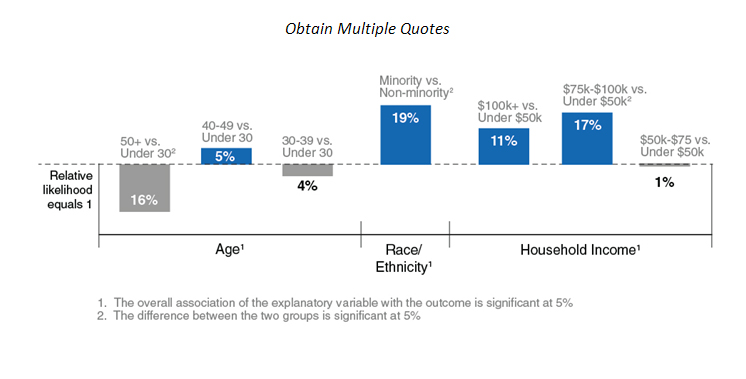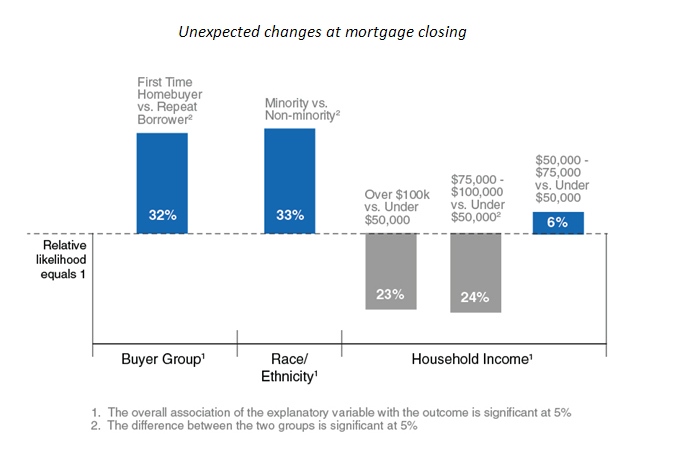What is the Mortgage Shopping Experience of Today's Homebuyer?
Lessons from recent Fannie Mae acquisitions

Prospective homebuyers must navigate the complex process of obtaining a mortgage. Research and consumer guidance suggest that obtaining multiple mortgage quotes and being better informed may help borrowers get a mortgage with a better set of financial terms1,2,3,4. Improved borrower outcomes also may benefit lenders in the form of increased customer satisfaction and retention.
By analyzing Fannie Mae's National Housing Survey™ data, we find that when controlling for multiple variables, our sample of recent Fannie Mae homebuyers' key shopping experiences and behaviors are most highly associated with income, age, level of previous home buying experience, and whether or not the buyer is a member of a racial/ethnic minority group5. The minority variable requires further examination due to sample size limitations within each underlying racial/ethnic group.
Our survey findings show that approximately one-third of recent homebuyers did not shop around for a mortgage, often reporting that they were satisfied with their first quote. Higher-income, younger-aged, and minority borrowers are more likely to obtain multiple quotes when shopping for a mortgage. Previous experience in getting a mortgage did not increase the likelihood of shopping for multiple quotes. First-time homebuyers and lower-income borrowers are more likely to say that referrals from friends, family, or co-workers had a major influence on their choice of lender. Only first-time homebuyers are more likely to say that a real estate agent’s or mortgage specialist’s referral influenced their choice of lender. When it comes to surprises at the closing table, first-time and minority homebuyers are more likely to report unexpected changes, though we see differences between the underlying racial/ethnic groups in the descriptive results.
These findings suggest that there is an opportunity to help consumers be better informed and improve upon the mortgage shopping process. In particular, consumers may benefit from better tools and advice from knowledgeable, objective third parties to assess the outcomes that lenders provide across multiple variables – such as cost, efficiency, and customer service – allowing them to balance these tradeoffs to best meet their needs. As large and infrequent as the mortgage transaction is in most people’s financial lives, borrowers may be leaving money on the table by not shopping around and negotiating for the best terms they can get. Getting a better deal can help borrowers sustain their mortgage even in the case of unexpected increases in expenses or decreases in income. The level of influence of referrals on today’s first-time and lower-income homebuyers suggests that finding a lender who delivers on other dimensions, such as efficiency and customer service, also is a key area of focus for many. What is not clear is the extent to which recent homebuyers are evaluating these referrals to determine how well the recommended lenders fit their needs and whether they are aware of referring parties’ interest, where applicable, in the housing transaction when making such an evaluation. Lenders have an opportunity to facilitate the shopping process by providing clear information for consumers about the different mortgage product choices they offer, which may help reduce unexpected changes at closing and increase customer satisfaction and referrals. Offers that are easier both to understand and compare to other offers might motivate more borrowers to shop around, particularly if they have a better sense of the financial savings they might achieve by doing so.
Encouraging homebuyers to seek multiple sources of information, determine the key criteria that are important to them, and ask detailed questions about the basis for a lender recommendation when shopping for a mortgage may help them find a lender that best meets their individual needs. This increased understanding in the earlier part of the mortgage-shopping process may help reduce the frequency of unexpected changes at the closing table.
Significant explanatory variables and their relative likelihoods over the baseline groups



Sarah Shahdad and Qiang Cai
Economic & Strategic Research Group
April 13, 2015
1 Berndt, Antje., Hollifield, Burton., and Sandås ,Patrik. 2010. “The Role of Mortgage Brokers in the Subprime Crisis." National Bureau of Economic Research Working Paper 16175. https://www.nber.org/papers/w16175.pdf.
2 Woodward, Susan E., and Robert E. Hall. 2012. "Diagnosing Consumer Confusion and Sub-optimal Shopping Effort: Theory and Mortgage-Market Evidence." American Economic Review, 102(7): 3249-76.
3 Berndt, Antje., Hollifield, Burton., and Sandås ,Patrik. 2013. How Subprime Borrowers and Mortgage Brokers Shared the Pie. Available at SSRN.
4 https://www.consumer.ftc.gov/articles/0189-shopping-mortgage;
https://www.federalreserve.gov/consumerinfo/fivetips_mortgageshop.htm
5 Recent homebuyers include first-time and repeat homebuyers whose loans were acquired by Fannie Mae (see full paper for further detail); Minorities here include Asians, Blacks and Hispanics, and Non-minorities include non-Hispanic Whites as reported in the National Housing Survey.
The authors thank Steve Deggendorf, Tom Seidenstein, Orawin Velz, Pat Simmons, Dave Keil, Patty Koscinski, Suzanne Barr, and Lisa O'Donald for valuable comments in the creation of this commentary. Of course, all errors and omissions remain the responsibility of the authors.
Opinions, analyses, estimates, forecasts and other views of Fannie Mae's Economic & Strategic Research (ESR) group included in this commentary should not be construed as indicating Fannie Mae's business prospects or expected results, are based on a number of assumptions, and are subject to change without notice. How this information affects Fannie Mae will depend on many factors. Although the ESR group bases its opinions, analyses, estimates, forecasts and other views on information it considers reliable, it does not guarantee that the information provided in these materials is accurate, current or suitable for any particular purpose. Changes in the assumptions or the information underlying these views could produce materially different results. The analyses, opinions, estimates, forecasts and other views published by the ESR group represent the views of that group as of the date indicated and do not necessarily represent the views of Fannie Mae or its management.
